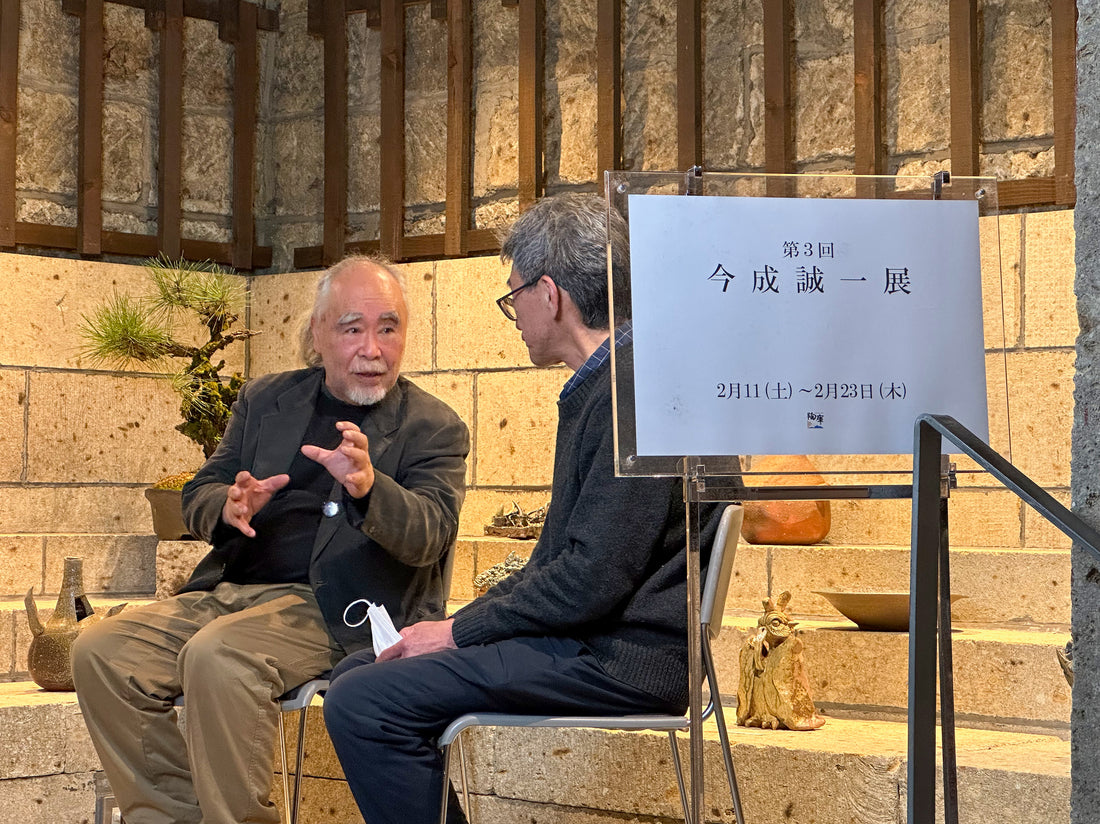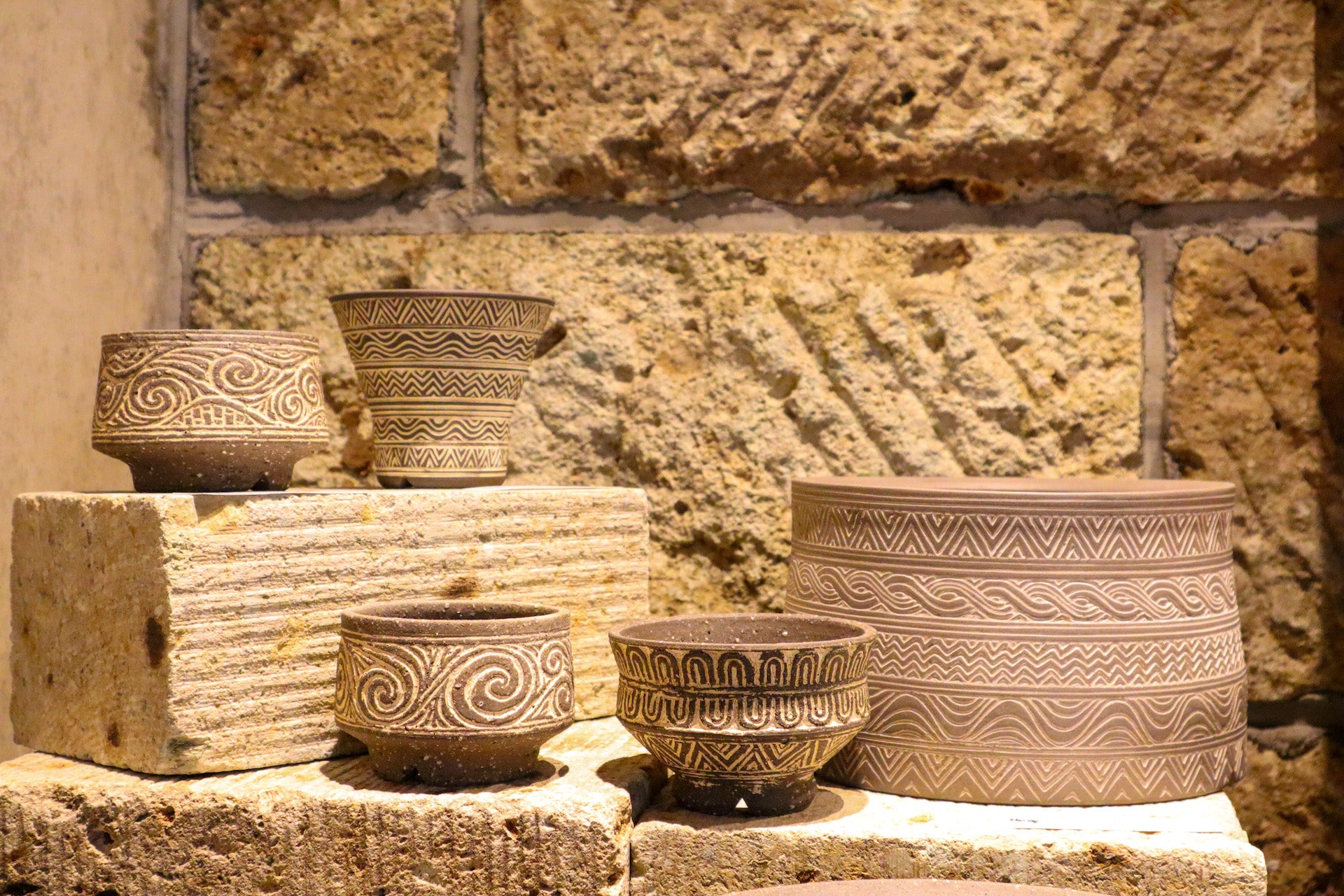
[TOKO CLUB EVENTS] Seiichi Imanari Gallery Talk
Share
"Seiichi Imanari Gallery Talk" held on February 18, 2023 in conjunction with the 3rd Seiichi Imanari Exhibition
Imanari is a popular artist who continues to create pottery, and even today he continues to express himself in a wide range of ways, from his days of creating pottery to his more sculptural work. In a talk session with the owner of the pottery store, we delved into the themes of his works and his thoughts and ideas about pottery making.

-Seiichi Imanari and his pottery storehouse-
Tsukamoto
Imanari's first exhibition was in May 2021, and this will be his third.
For some reason, the pottery storehouse had not had much business with Imanari, and when we spoke to him again, it seemed like we were largely at fault (laughs).
Imanari
No, no (laughs)
Tsukamoto
Apparently, you came to our pottery store 30 years ago to discuss a transaction, but I happened to be away. I told you I would visit you at the workshop later, but I never saw you again after that, and for that I am truly sorry.
Imanari
Not at all (laughs)
Tsukamoto
I've always had the impression that Imanari is a popular author.
I'm really sorry, but I had no idea that you were doing this kind of work.
We held our first exhibition two years ago, and as a gallery we felt very reassured that there are still people in Mashiko doing this kind of work.

-The theme of "living organisms"-
Tsukamoto
And this time the theme is "living organisms." When we talk about living organisms, does that mean you are expressing various living organisms in your own way?
Imanari
That's right. Broadly speaking, it's the Earth, and the universe, and I think of life forms within that category.
Imanari
They come in all different sizes, some smaller than a cell and some possibly larger than the universe.
In any case, the term "living organism" is vague, but there is a dualistic idea behind it.
In terms of life, it's life and death. In terms of things, it's birth, explosion, and end. In that sense, I think living things are easy to understand.
Imanari
I wanted to express the relationship between these three things: both of them and the non-living thing in between.
Tsukamoto
Does this mean that you have a strong sense of dignity for life?
Imanari
Yes. It's a sense of dignity, and I just feel like it's an amazing thing.
Tsukamoto
People today tend to have a self-centered way of thinking, but since the postwar period of rapid economic growth and the bubble economy, I think it's true that we tend to forget things like the preciousness of life.
It may be an exaggeration to call it a warning against this, but are you also considering sending a message to people today?
Imanari
I've always been basically indifferent to politics. But realistically, there are a lot of things we can't even think about, like war and crime. Natural disasters are inevitable, and we should all help each other out when they happen.
There was an earthquake in Turkey recently, wasn't there? I went there from Japan, and coincidentally, I have a friend from Kanagawa who always comes to my exhibitions, and his child went to the disaster area as part of a rescue team and returned. I don't have a TV at home, so I can't watch it, but my friend showed me the footage of the rescue team. Seeing that really got me thinking.
Tsukamoto
It is true that even after the recent earthquake in Turkey, relief was not reaching non-government areas of Syria, and this is entirely due to human convenience.There are still many cases in today's world where human lives that could be saved are not saved.
Imanari
Really. If you think about it simply, there seems to be an answer, but there are a lot of complicated ways of saying it and a lot of factors that go into it, and in fact there are a lot of wars that never end. I wonder what that is.
I've been interested in religion since I was a child, or rather since I was in junior high school, and although I was mainly interested in Buddhism, I was always interested. It's thought-provoking that such things can also lead to war.
Tsukamoto
Personally, I believe that if we do not regain this way of thinking, it will not be good for humans as living beings.
If we only talk about that sort of thing, it will get a bit heavy. (laughs)

-Ceramics and Expression-
Tsukamoto
The last time we had such a creative exhibition was Takashi Komine's "Compassion, Admonition," held at the Pottery Warehouse in November of last year.
In Komine's case, your method of making your work was to simply polish the clay, which is the material, and then shape it. In contrast, in Imanari's case, you fire your work in a wood-fired kiln. Is this the biggest factor behind your work?
Imanari
The way I express clay, which I like, feels most natural when made in a wood-fired kiln. Naturalness is a really great thing. If you try to force it, it ends up looking unnatural.
Wood-fired kilns are natural. That's why there's no progress. Everyone else tries to come up with new ideas, but I tend to just leave it as it is, so people often say to me, "You've made the same mistake again."
My late wife also said the same thing, and recently a young person I've been working with who works at a wood-fired kiln said to me, "Imanari, have you failed again?" (laughs).
Of course I do reflect on my actions, but I've always taken the stance that things will happen as they will.
Tsukamoto
In a sense, it's like entrusting it to the kiln, and seeing what kind of expression the living organism that I have created will emerge, and that's what makes pottery interesting and exciting.
Imanari
Yes, that's right. My kiln was destroyed during the Great East Japan Earthquake, so I had to rebuild it.
The original kiln was really big, so I asked them to make it a little smaller. But then, the part that got smaller ended up being a little bigger. (laughs)
It's no good shrinking a kiln once it's been made. In the end, only the length got shorter, and the width couldn't be changed.
So, it's not bisque, but it's covered in a lot of ash and has a lot of stored items on it.
There are several of these pieces in this exhibition, including one that has been refired in a gas kiln.
More than 10 years ago, a friend of mine said to me, "Are you just re-firing it?" but I thought it was interesting, and since then I've been obsessed with re-firing it in a gas kiln.
I re-create my previous works using high temperatures and various other patterns.
Of course, there's ash on top, but when you add pigments on top of that and do all sorts of other things, it's quite interesting.
Sometimes I realize later that the expression is different and that maybe that's what I was aiming for. When I remake something, I forget what I was aiming for, so there's no progress. But when I remake something, various things come out later, and there's a lot of variation, which is interesting.
Tsukamoto
Professor Goda Yoshimichi once said that when Kamoda Shoji built an anagama kiln, he complained that he couldn't fire properly and came to Goda for advice. Goda apparently advised him, "That's because you're trying to get this kind of fire. Shigaraki craftsmen in the old days would get their own firewood, so they didn't think of it as money, and they would fall asleep at night when they were tired, which actually made it harder to get good quality firewood." The more you try, the more difficult it becomes to fire a wood-fired kiln.
Imanari
My son may be like that too, but young people these days tend to do things very precisely, like they're following a manual. That's what I was taught at school, but I'm not naturally suited to it.
I also worked as a salaryman for about three years, but I couldn't continue. It was interesting in its own way, but I found it difficult to do it for the rest of my life.
Tsukamoto
It's true that in a way, it's important to deal with situations that arise haphazardly. This gradually becomes experience, and failures also become that kind of experience, and even if you don't know if they're directly connected, there is a connection in some way.
Mr. Imanari
All of my friends are very strict, and many of them mistakenly believe that they can help me grow by being strict with them rather than praising them (laughs).
So, I like him as a friend, but I don't like him saying too much about me (laughs).
My wife, who passed away at the age of 47, never said I was amazing, but she always told me I had potential. I was a little happy about that. No one says that to me anymore. (Laughs)
-Creative work-
Tsukamoto
I heard earlier that this type of work began around 2000.
So the Katamari series started just before his wife passed away.
Was there anything in your mind that you wanted to create a work like that?
Imanari
Yes. So when I make a little bit, my wife tells me, "Save that for the evening." Because evening is the time to drink. (laughs)
I think my wife wanted me to make something that would sell. I made tableware, and thankfully it sold quite well in various folk art stores. I was just carrying my creations around, and the store clerks asked me if I was making things too. (laughs)
I was shocked when they told me they thought I was just a delivery person. I had been holding solo exhibitions at the Ikebukuro Tobu department store every year for a long time. But people in the countryside don't know about it.
Tsukamoto
I think there is a 12-year age difference between Imanari-san and me. I returned to Mashiko when I was 24, so I think we came to Mashiko around the same time.
Imanari
Yes, that's true. I was around 35 years old at the time.
Tsukamoto
I think it was around 1986 or 1987, right when the bubble economy started, and even after it burst, sales in Mashiko continued to grow steadily. I think that was the period when Mashiko changed the most.
Up until then, there was a process called "kiln release," and when an artist's kiln was released, people from the retailer would go and select the pieces.
Imanari
Yes, my wife was taking orders over the phone every day, so I imagine it must have been quite a challenge just to produce the number of dishes that cost 500 or 800 yen.
Tsukamoto
I guess the desire to create something like this was always nurturing somewhere in my heart, and that's what led to the work I do now.
Imanari
That's right. Now that there's no one nagging me anymore, I can make as much as I want. But I'm at the stage where I'm not making any money. But now that I've finished raising my children and I'm no longer tied down by my family, I can make at my own pace. In terms of the gas kiln, I used to fire it three times a month, but this year I've only fired it about twice.
At the time, I was firing in a wood-fired kiln once a year, but now it's more like once every four or five years.
Tsukamoto
I don't make things, so I'm just saying this, but I feel that, financially aside, it's much richer in the spiritual sense.
Imanari
It's just the best. No one complains and we can somehow make a living. I'm really grateful.
Tsukamoto
I started a gallery called Art Space Jonaizaka in Touko in 1991. After renovating it into the current store, I continued to operate it until around 1998, but what happened during that time was that people doing that kind of expression gradually disappeared from Mashiko and Kasama.
I feel like there were a lot of people who were the opposite. They were young and made installations using figurative art, but as their work started to sell and orders started to come in, some people started to say that they couldn't work without orders.
From that perspective, I personally find the work and lifestyle that Imanari-san has very envious. It seems like a very ideal situation.

-From flower arranging to the world of pottery-
Tsukamoto
There are wintersweet flowers on display in this exhibition, but have you always been interested in flowers?
Imanari
I love fish and entered a university because it had a fisheries department, but in the end, the fisheries department was my first choice and I chose the agricultural chemistry department as my second choice because I just wanted to write something random. However, the fisheries department was quite popular at the time, so I ended up not getting my first choice.
I realized I couldn't afford to repeat a year, so I went to my second choice, the Department of Agricultural Chemistry. And Kenji Miyazawa was also in the Department of Agricultural Chemistry. At the time, I was a fan of Kenji Miyazawa, so I thought it would be a good idea.
When I joined the school, there was a flower arranging club, and I loved flowers.
It's been my thing since middle school. I used to commute to school by train, and I would see flower signs from the window, and I thought they were cool. I always looked at them and thought they were great. But when I told my grandma about it, she said, "Flowers are something women do," and for some reason, that made sense to me at the time. It's something men don't do.
That kind of thing had always been there, but when I went to university there was a flower arrangement club, and at the time there were relatively few girls in it.
There were a lot of guys wearing school uniforms, and once I joined I was hooked. I ended up spending more time in the clubhouse than in class.
I continued to study flower arranging as a student, going to various mountains to collect flowers, processing them, and assembling them.
So I decided that I wanted to pursue the path of flower arranging, which I had been doing for four years, and I talked to my teacher about it. My teacher supported me, but said that I needed to gain some experience as a working adult, so my teacher introduced me to a small trading company and I got a job there.
One day, when I went to a flower exhibition, I saw flowers arranged in Bizen vessels, and I felt that this was more interesting than flowers. So I went to Bizen, asked my teacher to apply, and I ended up entering Bizen.
Tsukamoto
I previously heard you say that you were practicing the Sogetsu school of flower arranging, but that your experience changed after seeing Nakagawa Yukio. What did you find particularly appealing about Nakagawa Yukio?
Imanari
I didn't know that. At the time, Sogetsu was run by Sofu Teshigahara, and he seemed like a really amazing artist. He was creating a series of works based on the Kojiki, and I thought that was amazing.
But Nakagawa Yukio was the complete opposite. He tied up flowers and squeezed the juice out of tulips, and at first I found that a little unpleasant.
But, as I look back at it, the things I've done up until now have a certain feel to them. But this one conveys the feeling that it's something that's at the risk of one's life. And it uses living things as the subject matter. And, because I felt I couldn't do that kind of thing, I turned to these vessels.
Tsukamoto
It was quite a shock.
Imanari
I agree.
Tsukamoto
So he went to Bizen, where he met someone from Mashiko, and came to Mashiko.
Imanari
Traditional crafts are like that. There's a pretty rigid hierarchy, and I just feel like it doesn't suit my personality. I had wanted to go independent in Bizen, but when I looked at things, I realized that I couldn't do that.
That's how it felt at the time, and when I thought I couldn't become independent, a friend told me he had a senior colleague in Mashiko and offered to introduce me to him, so I came to Mashiko. I didn't know anything about it, but when I came here I was surprised at how free it was.
Tsukamoto
It's true that Bizen, Hagi, Karatsu and other tea pottery makers have a truly feudal system, while Mashiko is not exactly democratic, although to put it in a positive light, there are many artists who feel that it is a free place.
Imanari
The first thing I felt was that, although not everyone is like that, the people around me seem to be operating in poverty. Bizen is actually quite wealthy. Most people have a window displaying their works there, and people come to see them. Customers and shop staff come from Kurashiki and other places.
When I gave an announcement about the kiln firing, people from Okayama City gathered and bought all the pottery at once. I sold any leftover pottery at my own solo exhibitions. I was quite blessed back then.

-How to understand ceramic works-
Imanari
My pieces also have kiln marks, cuts, and all sorts of other things. Shopkeepers often tell me, "These pieces don't sell as artwork," but I don't really mind that. As a buyer, though, those things are important, so I understand.
Tsukamoto
That's a difficult question, as everyone has different views. At Touko, we exhibit and sell our pieces, placing the utmost respect on the artist's expression. So, basically, if the maker says that even if there are kiln cracks, this is the character of the piece, we try to explain it to customers so that they can understand as much as possible.
That's what makes Bizen vases so appealing.
Imanari
That's right. That was interesting,
Tsukamoto
I think whether people find something interesting in such things varies greatly from person to person. Neither is necessarily better than the other.
Imanari
I once posted a piece I'd made on Facebook with the caption "I ended up making something like this." A friend commented on it and said, "What do you mean, 'I ended up making it!'" I'm sure that if someone were to be critical, they would wonder what I was trying to achieve. They said it was a coincidence, but it was inevitable.
Tsukamoto
As I mentioned in Komine's previous gallery talk, there is a certain inevitability to "beauty." If you look up "beauty" in the Iwanami Shoten Kojien dictionary, you will find that it means "inevitable." Its opposite is "pleasant," which is described as "accidental." This is merely the Kojien dictionary's interpretation, though.

-Gallery and Artist-
Tsukamoto
I haven't had many opportunities to talk about this sort of thing with Imanari-san, so I was able to talk to him without any preconceived notions. When your wife said earlier that there was "possibility," I felt something very strongly about it.
He is positive in everything he does. For example, he went to Kinki University, and although it may not have been his first choice, he discovered flower arranging in the Department of Agricultural Chemistry, and through that he discovered the charm of Bizen, and from there he moved to Mashiko.
I really feel that they have a very positive attitude and are finding potential in it.
And fundamentally, because you love fish and flowers, do you have a very strong respect for life?
As a retailer, we are very pleased to see the challenging expressions that are created in the pottery that is used for exhibitions.
Of course, it's a business, so both the makers and the retailers need to sell, but I don't think that lively or exciting products are necessarily things that sell.
I know it's not a good thing to say, but I've held exhibitions at the pottery storehouse by artists whose works sold out on the first day, and while I think it was good financially, I didn't find it very interesting. The customers were there to see the artists, so it didn't really matter what the items were.
When I think about it like that, I feel that these exhibitions bring the distance between the audience and the creators very close, and that providing a place for artists and audiences to meet is very rewarding.
This will be his third exhibition at Touko, and I would personally be happy if he continues to create such challenging expressions.
Imanari
thank you.




